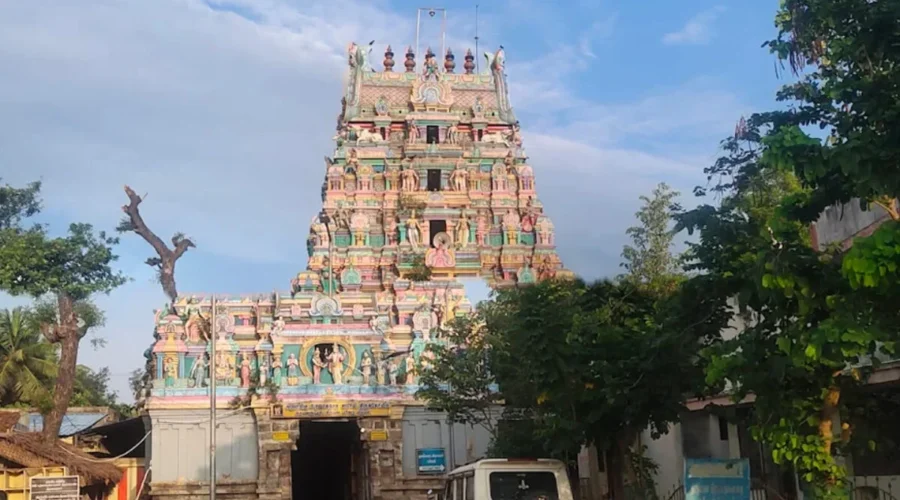Thirumanancheri Temple Pooja for Marriage & Love Life Blessings
When it comes to marriage wishes and rituals in Tamil Nadu, the name Thirumanancheri holds a special place.
Situated near Kumbakonam, this temple is dedicated to Lord Kalyanasundareswarar (Shiva) and Goddess Kokilambal (Parvati), and is believed to be the very site where the divine wedding of Shiva and Parvati took place.
Because of this, the temple has become famous as a marriage blessing shrine. Thousands of devotees visit every year with the prayer to overcome obstacles in finding a suitable partner, to get married at the right time, or to seek blessings for a harmonious married life.
In this article, Team Plannersy explains the special pooja performed at Thirumanancheri Temple for marriage blessings – how it is done before marriage and why couples return after marriage to offer thanks.
Significance of Thirumanancheri Temple in Marriage Wishes
The Thirumanancheri temple is a holy shrine in Tamil Nadu that is deeply tied to the belief that divine blessings from this temple deities can remove obstacles in your marriage or love life.
According to the locals of the village where this Mandir is located, it is believed that this is the sacred site where Lord Shiva married Goddess Parvati in their divine forms as Kalyanasundareswarar and Kokilambal.
Because of this, the temple is regarded as one of the most powerful places to pray for marriage-related wishes or overcome love life obstacles.
For centuries, devotees have been visiting Thirumanancheri Temple to:
- Seek blessings for early marriage if they are facing delays or obstacles.
- Find a suitable life partner with the grace of the deities.
- Ensure a harmonious married life after their wedding.
It is also customary for couples, after their marriage takes place, to return to this temple together. This act of thanksgiving is considered essential, as it completes the cycle of faith and devotion.
Step-by-Step Pooja for Marriage at Thirumanancheri
If you are visiting Thirumanancheri temple to pray for marriage blessings, here’s what typically happens during the ritual:
1. Purification Before Entry
Devotees bathe and wear clean, preferably traditional clothes before entering the temple. This is seen as a way of preparing oneself both physically and spiritually.
2. First Prayers at Ganesha Shrine
As in many temples, the first prayers are offered at Lord Ganesha’s shrine inside the complex. He is worshipped as the remover of obstacles, so devotees seek his blessings before the marriage pooja.
3. Darshan of the Main Deities
Next, devotees proceed to the sanctum of Kalyanasundareswarar (Shiva) and Kokilambal (Parvati) with offerings such as flowers, turmeric, kumkum, coconuts, and betel leaves.
4. Special Pooja for Marriage
At the temple counter, devotees can request the “Thirumana prarthanai” (marriage prayer ritual). The priest performs a special archana in the devotee’s name, often asking for details such as nakshatra (birth star) and gothram (lineage) if known.
- After the pooja, devotees receive a mangalya thread (yellow sacred thread), which is usually tied around the wrist or kept safely at home.
- They are also given prasadam (sacred offerings such as kumkum, turmeric, or vibhuti).
This step is considered the heart of the ritual, believed to remove marriage delays and attract divine blessings for a suitable partner.
5. Circumambulation of the Temple
After the pooja, devotees walk around the temple (pradakshina), usually 9 or 11 times, while praying sincerely for their wish to be fulfilled.
6. Keeping the Blessings at Home
The mangalya thread and prasadam are kept reverently at home until the devotee’s marriage takes place, symbolizing the continuity of blessings.
Returning After Marriage – The Thanksgiving Ritual
A unique aspect of Thirumanancheri temple is that the visit doesn’t end with the first prayer before marriage. Devotees believe that once their marriage takes place, they must return to the temple with their spouse to complete the vow.
During this second visit, the couple:
- Performs a thanksgiving pooja together in front of Lord Kalyanasundareswarar and Goddess Kokilambal.
- Brings offerings such as coconuts, turmeric, kumkum, and sometimes a saree and dhoti, which are presented to the deities.
- Receives prasadam once again, now as a blessing for a long, harmonious married life.
This ritual is seen as a way of expressing gratitude for the blessings already received and seeking divine grace for the journey of marriage ahead. Many devotees believe that this second step is as important as the first visit, as it symbolizes the fulfillment of faith.
Devotee’s Checklist for Marriage Pooja at Thirumanancheri
The following checklist reflects commonly observed offerings, sevas and practices at Thirumanancheri Temple.
Exact fees, specific sevas and timings are set by the temple administration and can change; please confirm details at the temple counter or the temple office when you arrive.
What to carry (The Essentials)
- Coconut(s): 1 or 2 (for pooja and breaking).
- Fresh flowers / garland: a small bouquet or a simple garland.
- Turmeric (manjal) & kumkum: small packets for offering and for receiving prasadam.
- Fruits / banana: one or two pieces as naivedyam.
- Betel leaves & areca nut (optional) : commonly used in traditional offerings.
- Small cloth / envelope with cash : for dakshina (donation) and pooja fees; many priests accept exact change.
- Piece of new cloth (optional) : saree/dhoti if you plan the thanksgiving offering after marriage.
- ID details & birth info : name, father’s name, date of birth, nakshatra (birth star) and gothram if known (priests often ask this for special archana).
- Small bag / pouch to safely carry the mangalya thread and prasadam home.
- Water bottle, face mask (if needed), sanitizer : practical items for the visit.
Attire & conduct
- Wear clean, modest clothes – traditional attire is recommended (saree/veshti or similar).
- Remove footwear before entering the temple premises.
- Keep phones silent and maintain a respectful, quiet demeanour inside the sanctum.
- Photography: Most inner sanctum areas do not permit photos – follow signage and priest instructions.
Timings & time required
- Best time: Early morning darshan is least crowded and more peaceful.
- Plan duration: Allow 1–3 hours depending on crowd levels and whether you book a special seva/archana. Special sevas take longer.
- Crowd tips: Weekends, festival days and special muhurthams (auspicious days) are busiest — arrive early.
How to request the marriage pooja (practical steps)
- Go to the puja/seva counter and ask for “Thirumana Prarthanai” or a marriage-specific archana.
- Provide your name, father’s name, date of birth, and nakshatra/gothram if asked.
- Specify whether you want the priest to tie the mangalya thread at the temple or simply give it to you as prasadam to keep at home.
- Pay the required dakshina / fee at the counter and take the receipt. Keep this until you complete the ritual after marriage.
Typical costs (approximate & indicative)
- Basic archana / small offering: usually a small donation (symbolic amount).
- Marriage pooja / special archana: small to moderate donation; for special sevas or priest-performed homams the amount can be higher.
- Thanksgiving offerings (after marriage): cost depends on the items you bring (saree/dhoti, coconuts, sweets).
Note: exact numbers vary widely by temple practices and special sevas – treat the above as a planning guideline and confirm fees at the temple office.
Can someone else perform the pooja on your behalf?
- Yes. Parents, siblings or close relatives commonly perform the pooja on behalf of a devotee.
- If you cannot attend in person, you can request team Plannersy to arrange proxy offerings or temple-appointed priests to conduct the ritual and issue receipts/prasadam on your behalf.
Keeping the mangalya thread & prasadam
- How to store: keep the thread and prasadam in clean cloth or an envelope in your home puja area.
- When to tie the thread: some tie it on the wrist at the temple; others keep it safely until the marriage day. Follow family tradition or priest guidance.
- After marriage: return with your spouse to present the thanksgiving offerings and complete the vow.
Accessibility & travel tips
- Parking & facilities: many temple complexes have basic parking and drinking water; carry cash for small purchases.
- Combine visits: Thirumanancheri is near other temples in the Kumbakonam region – consider planning a calm morning or full-day temple trip.
- Respect local customs: follow temple signage, priest instructions and local dress codes.
Pro tips from Team Plannersy
- Arrive early on weekdays for a quicker experience.
- Carry exact change for donations – it speeds up the process.
- Note down priest/office contact (if given) for follow-up about special sevas or receipts.
- If you require a specific muhurtham (auspicious time) for a ceremony, check with the priest in advance – they sometimes schedule sevas for specific muhurthams at an extra charge.
- Keep the thanksgiving visit sacred – coming back with your spouse is seen as completing the devotion; plan this visit as a meaningful ritual rather than just a checklist item.
Frequently Asked Questions on Thirumanancheri Temple Pooja for Marriage
1. Can the pooja be performed if the devotee cannot personally visit?
Yes. Traditionally, parents or close relatives can perform the pooja on behalf of the devotee. What matters most is faith and sincerity in offering the prayers.
2. How many times should one visit Thirumanancheri Temple?
Usually, there are two visits:
- The first visit before marriage for performing the marriage blessing pooja.
- The second visit after marriage with your spouse, to perform the thanksgiving ritual.
3. Is online booking available for Thirumanancheri pooja?
Currently, there is no widely available online system for booking the specific marriage blessing pooja. Devotees generally go directly to the temple counter on arrival.
4. Is the mangalya thread compulsory?
Yes, the yellow mangalya thread is considered an essential part of the ritual. It is a symbol of divine blessing for marriage and is either tied at the temple or kept safely at home until marriage.
5. Can Plannersy help if I am unable to travel to the temple?
Yes! If you are not able to attend in person, Team Plannersy can help perform the pooja on your behalf with complete devotion and transparency.
How Plannersy Helps You with Thirumanancheri Temple Pooja
We understand that not every devotee can personally travel to Thirumanancheri Temple due to distance, time, or personal reasons. That’s why Team Plannersy offers assistance to ensure your prayers are still performed sincerely.
Here’s how it works:
- Share your details with us – Your name, birth star (nakshatra), gothram, and basic information needed for the archana.
- We arrange the offerings – Fresh flowers, coconuts, turmeric, kumkum, garlands, and dakshina are purchased on your behalf.
- Pooja performed in your name – Our representative coordinates with the temple priests to perform the Thirumana Prarthanai ritual in your name.
- Donation on your behalf – We ensure the correct amount is given as dakshina and seva fees at the temple.
- Prasadam delivered to you – Once the ritual is complete, the prasadam (kumkum, turmeric, mangalya thread, etc.) is securely packed and sent to you via courier.
This way, even if you cannot visit in person, you can still receive the blessings of Lord Kalyanasundareswarar and Goddess Kokilambal.
Closing Notes by Team Plannersy
The Thirumanancheri Temple pooja for marriage is a cherished ritual rooted in centuries of faith. Whether you are praying for a timely marriage, a suitable life partner, or a harmonious wedded life, the temple offers solace and hope.
And if distance or commitments keep you from being there, Team Plannersy is here to help. With devotion and care, we make sure your prayers are offered and prasadam reaches your home.
Related Reads from Team Plannersy
For those interested in temple-based rituals and blessings for weddings, here are some curated articles by Team Plannersy that you may find helpful:
| Article Title | Description |
|---|---|
| Famous Temples in India for Weddings | Explore some of the most popular temples across India that are considered ideal venues for wedding rituals and ceremonies. |
| Temples for Marriage Wish Fulfillment in India | A guide to temples that devotees visit to pray for marriage blessings, including love marriage and early marriage wishes. |
| Sending Wedding Invitation Cards to Temples in India | Learn the tradition of sending your wedding invitation to temples, its spiritual significance, and how it is performed respectfully. |



